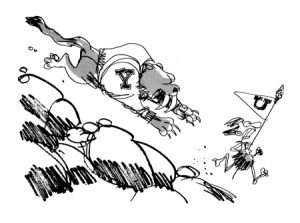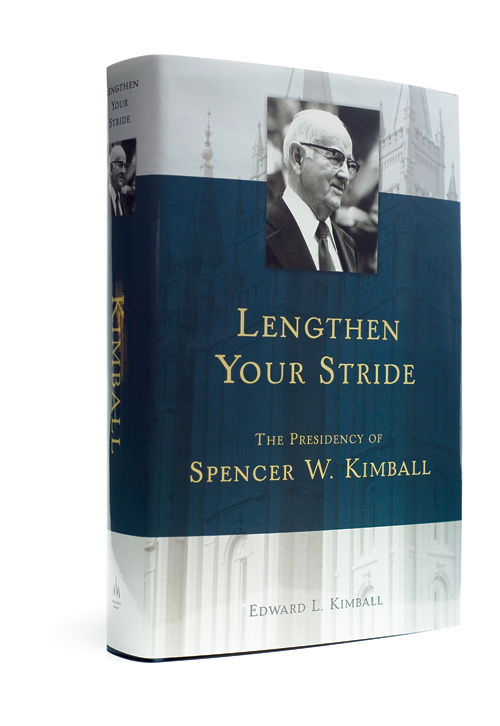Dear Editor:
Upon reading the editorial page of this newspaper I am disgusted by the extreme superficiality of the content. The editorial section of this newspaper is a great opportunity to present thousands of students with information and new viewpoints. Instead, so many are using it as a place to whine about how people live their lives.
Andrea J. Bailey, ’02
Salt Lake City
12-19-2000
Dear Editor:
I have to respectfully disagree . . . in regards to keeping the letters to the Daily Universe about real issues and not using it as a forum for the petty whining so many students choose to get caught up in. I say keep those letters coming. The opinion section was one of my greatest sources of amusement and laughter during my college career.
John E. Moyer, ’94
Los Angeles, Calif.
12-21-2000 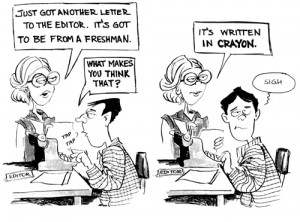 THE DAILY UNIVERSE opinion page is the cultural equivalent of Newton’s third law of motion. No matter the topic, an opinion printed there will give rise to a reaction of equal strength but opposite direction.
THE DAILY UNIVERSE opinion page is the cultural equivalent of Newton’s third law of motion. No matter the topic, an opinion printed there will give rise to a reaction of equal strength but opposite direction.
From parking problems to the nuances of the Honor Code to the push for patriotism, the letters to the editor have always been a popular destination for readers ofBYU‘s student newspaper.
“There are probably two types of opinion-page readers out there,” says former editor Erin Gunnell Burt, ’01. “The first group reads it because they are truly interested in the issues of BYU, its students, and the surrounding community. The second group reads it for pure entertainment.”
While a student at BYU, Jay D. Evensen, ’83, was the Universe‘s editor—”probably the greatest title you can ever have in your life.” Now he is editorial page editor at the Deseret News and teaches a BYU opinion-writing class. A lot of students go to the Universe editorial page first, says Evensen, because “they feel some kind of ownership. If I could get the readers of the Deseret News to want to look at that page as much as the students here want to look at the Universe page, I’d feel great.”
Twice a week during fall and winter semesters, the Daily Universe opinion editor, usually a senior journalism student, determines which of the 40 to 50 letters submitted that week to print in the paper. Traditionally, these letters begin with “Dear Editor: I am shocked and appalled . . .” Other writers have been saddened, sickened, or dismayed by a wide variety of global, administrative, or personal offenses.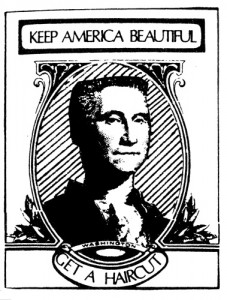 There is rarely a lack of material to print; members of the BYU community cannot resist a good debate. Like an attractive returned missionary on campus, an opinion ventured in the letters to the editor will not be alone for long.
There is rarely a lack of material to print; members of the BYU community cannot resist a good debate. Like an attractive returned missionary on campus, an opinion ventured in the letters to the editor will not be alone for long.
For example, in September 1978, when Lynn R. Sessions, ’80, of Vernal, Utah, proposed adding two more letters to Y Mountain (B and U, of course), the subsequent letters section held a tongue-in-cheek response from Norman A. Darais, ’71:
Editor:
Let’s carry this good suggestion a little further. Why not add all the letters in the school name—since we would only need 21 more. Or maybe we should consider covering the entire mountain with concrete. Then we could paint whatever we want on the mountain, or, for the ultimate touch of class, we could cut the school letters out through the concrete facade. In so doing, the letters themselves would be displayed through the concrete in beautiful mountain colors (which would change with the seasons).
Covering the entire mountain with concrete, although somewhat expensive initially, would also eliminate any future worries of erosion.
While reader comments can be sarcastic, they can also, on rare occasion, be uncharacteristically kind. One such message came in January 1968 from Kathryn Robbins Ashworth, ’63: “To the fellow in line at the campus P.O. Monday afternoon: After a couple of confrontations with belligerent male drivers in the bookstore parking lot, your offering me your place in line seemed especially gracious and refreshing. Thank you.”
And although many of the letters are filled with biting social commentary, five young women had only this to say in a March 1968 letter: “Our only complaint against the average BYU male is that he is married.”
There is a definite cycle to topics broached in the student paper over the years. Faculty often ask John S. Gholdston, ’86, managing director of NewsNet and theDaily Universe, “Didn’t we just do this a year ago?”
“Well yes,” says Gholdston in response, “30 percent of our students are gone. And unlike most newspapers, we turn over our audience within a five- or six-year period. So we do reengage with some of these issues—things pretty unique to our particular environment. Always we have great discussions and fervent scripture quoting. It’s always interesting to watch.”
When readers perceive that a topic has exceeded its life span, they often turn the letters themselves into a topic of discussion. In March 1999 Reed Spencer, of Orem, Utah, explained his reaction to recurring topics:
Dear Editor:
I like to listen to people rant just as much as the next guy, but when the ranting is about the same thing every time, I feel like I’m being subjected to Chinese water torture. The repetition makes my brain feel all tingly, and I lose the desire to read the letters to the editor. The editorial page is getting boring. We seem to dwell on the same subjects. For the past weeks (months or years for some of these topics), the letters to the editor have been about one of three things: 1. Judging other people: the pros and the cons. 2. The Honor Code: why they don’t trust us. 3. Materialism: the evils of cargo pants.
Can’t we come up with something more interesting and pertinent? I think that we, as a community of saints, can pull together and do it. I’d like to start off by presenting a fresh opinion. I used to hate going to the bathrooms here and using the paper towel dispensers that you had to crank by hand. And those brown, stiff paper towels? They didn’t feel very good on my hands. But somewhere along the line, someone high up on the ladder said, “Hey, if BYU is going to be a world-class university, we need better paper towels.” Kudos to you, whoever you are. I love the new Kimberly-Clark paper towel dispensers.
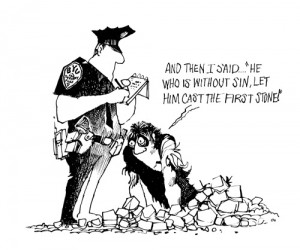 The thematic cycle extends beyond weeks and months—some ideas expressed 100 years ago recur and resonate today. Consider these words from a B.Y. Academy student published in the White and Blue in March 1900: “Something is wrong with the athletic society. While the base ball team is forging ahead, we hear nothing of the track team. Where are the vaulters, the putters of shot, the runners, the jumpers, the throwers of the hammer?”
The thematic cycle extends beyond weeks and months—some ideas expressed 100 years ago recur and resonate today. Consider these words from a B.Y. Academy student published in the White and Blue in March 1900: “Something is wrong with the athletic society. While the base ball team is forging ahead, we hear nothing of the track team. Where are the vaulters, the putters of shot, the runners, the jumpers, the throwers of the hammer?”
In January 2001 a letter in the Daily Universe from Preston D. Taylor, ’00, sounds familiar:
I am writing in response to the article that appeared last week regarding successful sports at BYU that do not receive the recognition they deserve. I want to make mention of another sport that has consistently been overlooked throughout the year—Rugby. It seems unfair that the team with the best winning tradition has gone virtually unnoticed for the past 20 years.
Safety, especially walking alone at night, is another recurrent theme. Under the title “Observations, Wise and Otherwise,” in a November 1898 issue of the White and Blue, comes this insight:
Prof. Brimhall’s advice in regard to young ladies not going out in the evening without an escort, should be heeded. If two girls of the third domestic ward had followed out his instructions in this matter, they perhaps would not have deliberately walked into a large water ditch last week. They were heard to say next morning that the incident would have been pleasant had it not been so cold.
A February 2001 letter from Eden Anderson, ’03, of Draper, Utah, encourages walking home with campus law enforcement officers in a program called SafeWalk. At first Anderson was reluctant to call for an escort. “When I mentioned this embarrassment to the two policemen walking me home one evening, they said, ‘We were on our eighth time circling the Benson Building, and those walls aren’t anything exciting. Call anytime, and tell your friends to call too!'”
The perils of pedestrians in Provo is a regular topic. In this December 1938 letter from John Utvich, ’40, published in the Y News, replace the reference to 2nd East with 9th East and raise the speed of automobiles to 35 miles per hour and it could have been written yesterday.
B.Y.U. is preeminently a “friendly” school, where these morons (wreckless drivers) say “hello” and smile at strangers as they mangle them beneath their wheels.
I see no reason for throwing away years of my life because the nut who holds on the wheel is loose.
During the past week I have seen three or four cases where accidents were narrowly averted. Why students persist in driving on 2nd east between 7th and 8th north between classes is more than I can see. Why they drive more than 5 m.p.h. there I cannot see.
Athletics, campus security, and the clash between pedestrians and drivers are staples of cultural commentary. The trials associated with a growing student population—parking, traffic, food services, security, construction—also consistently consume newsprint. This question is from February 1968: “Editor: How long does it take to reroof the McKay Building? (signed) Sick of Tar Scent.”
But once the dust clears, beneficiaries of new facilities echo the sentiment of 1901 class editor William M. Hughes in November 1898, “Our new quarters in the College building are commodious and much pleasanter than were those we occupied last year.”
Always mindful of their campus environment, BYU students often offer ways to cut costs. “After much deliberation,” in February 2000 four innovative students “settled on one with much potential: allowing sheep to graze on BYU grounds.”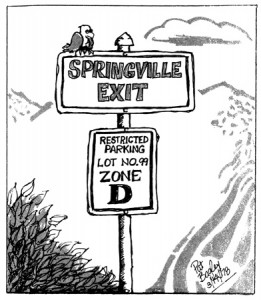 This solution has wonderful possibilities. It will dismiss the costly grounds crew, lowering tuition. The sheep will crop the grass, bushes, and flowers, and will consume litter. This also eliminates the horrible grinding noise of the lawn mowers that often disturbs students. The sheep will also fertilize the grass. Natural fertilization is cleaner for underground water supplies.
This solution has wonderful possibilities. It will dismiss the costly grounds crew, lowering tuition. The sheep will crop the grass, bushes, and flowers, and will consume litter. This also eliminates the horrible grinding noise of the lawn mowers that often disturbs students. The sheep will also fertilize the grass. Natural fertilization is cleaner for underground water supplies.
Sheep-shearing will provide wool for shirts, pants, and suits to be sold at the BYU Bookstore, lowering the business’ overhead and providing a self-sufficient emergency clothing supply. The biology department can advance the field of genetic engineering by changing the black-wool sheep into blue. The sheep will then provide a cheerful dose of school spirit to the grounds and the wool won’t need dye.
In March 1999 Benjamin K. Nielson, ’01, sought support for his campus improvement:
Dear Editor:
I think the stinky tree behind the Eyring Science Center should be removed. . . . The tree drops things, probably reproductive thingys, but that’s not my area of interest. What bothers me is the smell of those things when people step on them. I mean, it’s not that I’m against trees on campus, in fact, I kind of like trees. It’s just that particular tree. Did I mention it smells bad? I want it removed, and I don’t think I’m the only one.
Well I don’t know who’s in charge of that sort of thing, but I figured this is the easiest way for them to hear about it and to hopefully get the support of others who feel the same way.
On a given day the Readers’ Forum may contain a letter easily labeled trivial or ridiculous. The pros and cons of chewing gum, walking on the grass, or sporting a fad hairstyle beg the reader for a quick letter of rebuttal in the next paper. But what is trivial to one person may be a heartfelt concern for another.
The important thing, according to Gholdston, is that the audience has a voice, even for a less-than-serious topic. “One man whom I greatly respect said to me, ‘Some of these editorials are so sophomoric!’ And I said, ‘Well, that’s because a lot of them are coming from sophomores!’ You would expect them to be sophomoric. If we ran only things that came from the Law School, or from other graduate programs, it would be a higher level of discussion, but you would be obviating the opportunity for the sophomores to have a say.”
Gholdston says that without discussion—a way to develop depth in our thinking process—our pool of reasoning remains shallow.
In the 1950s the letters section was titled the Safety Valve—a place where the pressures of an expanding campus and student population could be vented. Ralph D. Barney, ’57, a BYU professor emeritus of communications, was Universe editor in 1956–57.
“A serious problem at BYU, and probably a lot of other places, is that a lot of the students have a feeling of insignificance. ‘Nobody ever listens to me. I have these things to say, and nobody listens to me.’ So I think that’s one of the first services the letters to the editor afford, because people get the feeling, ‘I have an outlet. I can express myself, and people will listen, even if nothing comes of it. I will have at least expressed my view.'”
The BYU student population in 1957 was between 7,000 and 8,000. According to Barney, one of the most important roles of the Universe was to bring people on campus together. “Unless there’s a catalyst, you don’t have a gathering.” He penned the following letter that “bemoaned the fate of men over 25 who were bachelors.”
The time has come, it is felt by two certain bachelor newspaper editors, for the formation of a society or group on campus which we would call the SBOTFMAA.
This organization, Senior Bachelors-Over-Twenty-Five Mutual Assistance Ass’n., is sorely needed for those members of the male student body who are faced with the bleak prospect of graduating this coming June without having wooed and won one of those delightful members of the fair sex which abound in such profusion on this, the most blessed of campuses.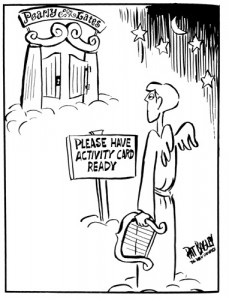 Barney proposed that “regular meetings . . . be held at which guest speakers would be invited to address said bachelors on the finer points of developing the necessary persuasions for the winning of fair ladies.” Barney concluded, “Even a pooling and exchange of ideas and technique between members of the association would be a most valuable thing.”
Barney proposed that “regular meetings . . . be held at which guest speakers would be invited to address said bachelors on the finer points of developing the necessary persuasions for the winning of fair ladies.” Barney concluded, “Even a pooling and exchange of ideas and technique between members of the association would be a most valuable thing.”
His column resulted in the formation of a club that lasted for two years and instilled a significant sense of belonging to its members. Barney adds, “The letters page tells people that there’s somebody else in the system who has the same problems and same feelings as you do. It allows people to recognize that they’re not alone.”
A letter to the editor is an outlet for an individual voice in a community of thousands, says Gholdston—one way for individuals to gather information and reach conclusions. “It’s imperative that, not just as newspaper people but as Latter-day Saints, we make informed decisions,” he says. “Whether we persuade an audience or not, the prominent point is that we get them thinking about it, motivate their processes, so that they will reach conclusions.”
Former opinion editor Erin Burt agrees. “When we question the world we live in, we can initiate change. I believe that change is born in the minds of the people.” She adds, “I am a firm believer in giving equal opportunity for differing opinions. It is when we question the thoughts and opinions of others that we begin to think for ourselves. Isn’t that what college is all about?”
That’s one opinion. In this February 2001 letter, Abigail E. McCutcheon, ’02, of Elk, Wash., shares another:
Dear Editor,
Let’s be honest with ourselves. Nobody really likes to read all of these intellectually stimulating Readers’ Forums we’ve been having lately!
I mean, I know I’m not the only one who misses reading Tuesday and Thursday editions and sighing in disgust at the name-calling, narrow-minded, sarcastic letters.
I don’t want to open up the paper and see words like usurpation, eviscerate, and quip. I want to see “shame on you,” “self-righteous,” and “Honor Code violation.” . . .
So, let’s put the entertainment value back into the Readers’ Forum; Tuesdays and Thursdays will be better for everyone!
WEB: Read the Daily Universe letters section online at universe.byu.edu.







